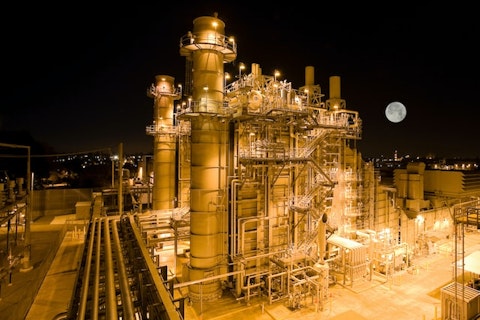Alliant Energy Corporation (NASDAQ:LNT) Q4 2022 Earnings Call Transcript February 24, 2023
Operator: Good morning, and welcome to Alliant Energy’s Conference Call for Fourth Quarter and Year End 2022 Results. This call is being recorded for rebroadcast. I would now like to turn the call over to your host, Susan Gille, Investor Relations Manager at Alliant Energy.
Susan Gille: Good morning. I’d like to thank all of you on the call and the webcast for joining us today. We appreciate your participation. Joining me on this call are John Larsen, Chair, President, and CEO and Robert Durian, Executive Vice President and CFO. Following prepared remarks by John and Robert, we will have time to take questions from the investment community. We issued a news release last night announcing Alliant Energy’s fourth quarter and year-end 2022 financial results and affirmed our 2023 earnings guidance. This release as well as an earnings presentation will — which will be referenced during today’s call are available on the Investor page of our website at www.alliantenergy.com. Before we begin, I need to remind you the remarks we make on this call and our answers to your questions include forward-looking statements.
These forward-looking statements are subject to risks that could cause actual results to be materially different. Those risks include, among others, matters discussed in Alliant Energy’s press release issued last night and in our filings with the Securities and Exchange Commission. We disclaim any obligation to update these forward-looking statements. In addition, this presentation contains references to non-GAAP financial measures. The reconciliation between non-GAAP and GAAP measures are provided in the earnings release which is available on our website. At this point, I’ll turn the call over to John.
John Larsen: Thank you, Susan. Hello, everyone, and thank you for joining us. 2022 was another successful year of solid operations and financial performance. This was our 13th straight year of delivering results in our 5% to 7% adjusted EPS growth range and the 20th year, two decades straight, of consecutive dividend increases. We had one of our best reliability years on record with top-tier performance. Our wind generation produced the most wind energy in our history, providing approximately $160 million of fuel cost savings for our customers. We continued our progress towards net zero, decreasing carbon dioxide by nearly 40% off of 2005 levels, and we kept up 2022 with very strong economic development in both Iowa and Wisconsin with over 100 megawatts of announced load that will bring new jobs and new investments.
As I reflect on the past year, what makes me most proud of Alliant Energy is the continued dedication and service from our employees. As they strengthen our connection with the customers and communities we proudly serve. In 2023, we will be celebrating Alliant Energy’s 25th year. I’m proud to be part of Alliant Energy. I’m proud of our team, and I’m inspired by our purpose to serve customers and build stronger communities. Our employees focus on this purpose has enabled us to once again, deliver the results you have come to expect from Alliant Energy. Our purpose continues to be the source of our strength and guides us through the ever-changing dynamics, within our economy and our industry. I’ll highlight a few areas of progress and then turn it over to Robert to recap financial results and provide an update on regulatory proceedings.
In 2022, we continue to execute on our Clean Energy Blueprint by adding renewables in the states where our customers live, which allows us to invest in the communities we served and add skilled union jobs and local revenues. This is another example of how our purpose is at the center of our strategy. We added 250 megawatts of solar at our Bear Creek, North Rock and Wood County Wisconsin sites, positioning us as the largest owner-operator of solar generation in Wisconsin. We are on track to bring into service an additional 850 megawatts of utility-scale solar, by the first half of 2024 in Wisconsin. We continue to progress our Clean Energy Blueprint in Iowa, advancing renewables and our efforts to place electric lines underground, improving the reliability of our system.
And while we are not yet at the conclusion of the advanced ratemaking process in Iowa for our solar and storage projects, we continue to follow the well-defined steps within the regulatory and procedural process to demonstrate that these projects are cost-effective and reasonable. We remain confident these projects are in the best interest of our customers and will supply the energy, reliability and resilience, that our customers depend on. Another great success story is the advancement of solar gardens. We are building one near Cedar Rapids, Iowa with Transamerica and Aegon as our main customers. And we’re partnering with Mercury Marine in Wisconsin to build a similar solar facility. These projects help advance the sustainability objectives of our customers.
And we also use these local investments to advance our focus on the social part of ESG, providing some of the solar energy to partners like Habitat for Humanity. This continued focus on economic development and our customers were contributing factors, in being named a top utility in economic development by Site Selection magazine, for the fourth year in a row. And I’m proud to say that this work also contributed to the recently being awarded the Chairman’s Award for Workforce Development leadership, which is the center for energy workforce development’s highest honor. While we were proud to receive many recognitions this past year for the work that we do in our communities, the recognition I’m most proud of, focuses on our employee experience.
For the fifth year in a row, we were named by the Human Rights Campaign Foundation, as the best place to work. And for the fifth year in a row to Forbes list of America’s best midsized employers. And speaking with many of you, one of the things I’m reminded of is our strong core investment thesis. That is why you choose to invest in our company. Simply put, we delivered consistent results. Our well-executed forward-thinking and flexible strategy, coupled with constructive regulatory jurisdictions, has been a major part of our success. We not only deliver near-term results, but continue to take steps to help reduce future risks and provide the stability investors have come to expect from our company. A well-executed strategy has positioned us as a leader on the path to a clean, reliable and affordable energy future.
We are well positioned to quickly adapt to a dynamic economic environment and weather challenges, while delivering on investor and customer expectations. 2022 was a clear example of this. Our efforts to move lines underground, continue the advancement of solar projects and strong operations in the face of weather events. While delivering solid results for our investors and reliable service for our customers, underscores the flexibility of our strategy and the dedication of the team, I am privileged to lead. And speaking of dedication, I want to pass on my appreciation to our employees that have worked through difficult conditions in the recent weather event to safely restore our power to our customers. As we move forward in 2023, you can have confidence that we will continue to take the required action that is needed to meet our customers’ needs.

Photo by American Public Power Association on Unsplash
We thank each one of you for continuing to be engaged in our journey and we look forward to connecting with you throughout 2023. At this time, I will now turn the call over to Robert.
Robert Durian: Thanks, John. Good morning, everyone. Yesterday, we announced 2022 GAAP earnings of $2.73 per share compared to $2.63 per share in 2021. On an adjusted basis, which excluded the impacts of temperatures and non-recurring adjustments, our earnings per share increased 6% from 2021. Looking year-over-year, the increase in 2022 was driven by higher earnings from capital investments at our Wisconsin utility and higher electric and gas margins. These favorable drivers were partially offset by higher financing and depreciation expenses. Our diverse retail customer base supported the higher electric and gas margins in 2022. Residential temperature-normalized electric sales increased by almost 1%, largely due to strong customer growth.
We also saw higher-than-expected sales from commercial customers with continued recovery from COVID for several business sectors in our service territory. These were offset by lower industrial sales, primarily due to temporary plant shutdowns at some of our larger customers. In 2022, we also saw a better than expected temperature-normalized natural gas sales enabled by solid customer growth. The 2022 results we are sharing today are result of our consistent efforts to manage through and mitigate ongoing inflationary pressures. We’re extremely proud that we kept 2022 utility operating expenses in line with 2021 and we were able to manage through and offset the negative impacts on earnings from rising interest and fuel costs. Our work in 2022 accelerated strategic initiatives that will set us up for many years to come.
We invested in economic development and electrification that will enable future sales growth. We updated our resource planning to maximize Inflation Reduction Act benefits, and meet the new MISO seasonal reliability requirements. And we accelerated technology and automation investments to improve efficiency. As we look to 2023, we anticipate operating and maintenance expenses will be lower than 2022, continuing our trend of flat to declining O&M to enable cost savings for our customers. We recorded a few nonrecurring adjustments in 2022. These included $0.03 per share related to the Iowa state income tax rate change, $0.02 per share related to retirement plan settlement losses, at the end of 2022 and $0.02 per share related to a reserve adjustment for American Transmission Companies base ROE changes.
Turning to 2023. We are positioned for another year of consistent 5% to 7% earnings per share growth. We are affirming our 2023 earnings guidance range with a midpoint of $2.89 per share, representing a 6% increase over 2022 adjusted earnings. Our 2023 earnings drivers include earnings on customer investments in our core utility business, and our continued efforts to reduce cost to increase customer value. Higher depreciation and financing expenses associated with these investments will partially offset these positive drivers. Our efforts to support customer value through making smart investments in our future support our ability to consistently deliver strong financial results. Other key assumptions for 2023 include growing sales by approximately 0.5% of 1%, led by higher sales to our commercial and industrial customers.
And we estimate a consolidated effective tax rate of 1%, with substantial production tax credits generated by our large wind portfolio and growing solar portfolio, helping us maintain low effective tax rates for the upcoming year and several more years to come. The benefits from these production tax credits are passed on to our electric customers to help them manage their bills and therefore, are largely earnings neutral. Our financing plans for 2023 include a mix of new debt supplemented with modest new common equity to finance our investments in renewable projects and to support refinancing a $400 million debt maturity in 2023. In December, we launched an At The Market or ATM program as our intended approach for raising up to $225 million of new common equity throughout 2023, which is in addition to the $25 million of common equity that we expect to raise under our DRIP finance.
And in January, we entered into an interest rate swap to help reduce the risk of rising interest rates related to a portion of our variable-rate debt. The 2023 financing plan is driven by robust capital expenditure plans and supports our objective to maintain the capital structures at our two utilities consistent with our most recent regulatory decisions. Next, I’ll highlight this year’s key regulatory initiatives. Last month, we provided additional testimony and evidence to the Iowa Utilities Board and IPL’s advanced remaking proceeding. This testimony and evidence further demonstrates that IPL is taking prudent actions to meet its customers’ need for capacity by advancing Iowa-based solar and storage projects that represent cost-effective solutions compared to alternative options available in the market.
We also informed the IUB that we have identified our self-developed Creston and Wever projects as the second 200 megawatts of solar products, in addition to the 200 megawatts build transfer solar projects at the Duane Arnold site. To date, we’ve provided all the information requested by the IUB demonstrating that these projects are in the best interest of our customers. The IUB’s decision this week to pause the advanced rate making process is procedural. We are working through both the regulatory and judicial processes in parallel, and following the well-defined process to move these projects forward. Next, we expect the IUB to file a response with the District Court in early March. We are confident these projects will provide considerable customer benefits, including reliability and resiliency and remain committed to executing these projects while we await the IUB’s final rule.
In Wisconsin, we are awaiting a decision from the PSCW on WEC Energy’s purchase of a portion of our West Riverside natural gas generating facility. We are also anticipating decisions from the PSCW in 2023 on WPL’s request for 274 megawatts of battery storage. 175 megawatts of these battery projects would complement 2 of WPL solar projects and 99 megawatts of the battery projects will be located by our Edgewater Generating Station to take advantage of the existing infrastructure and transmission rights at that location. Finally, we plan on filing a normal biennial electric and gas rate review in Wisconsin for test years 2024 and 2025 in the second quarter. In both states, we are also anticipating making filings to support additional resources for growing dispatchable generation capacity, needed to improve seasonal reliability and meet customer energy needs.
As always, we continue to move forward proposing energy investments that support both sustainability and resiliency, keeping our customers’ needs top of mind. I will conclude with a recap of the prominent legislation enacted this past year that has set us up for a solid future financial success, while providing significant customer cost benefits. Alliant Energy is a strong beneficiary of the Inflation Reduction Act. As it directly supports our strategic plans to advance cleaner energy for our customers, while providing significant customer and investor benefits. The IRA enables additional rate base opportunities while also lowering customer costs with a shift from tax equity to full ownership for our planned solar and battery projects. In our November 2022 refreshed capital expenditure plan, we incorporated the benefits of the IRA along with the changes from the MISO seasonal construct, which provides visibility to our planned 8% rate base growth through 2026.
Another key element of the IRA improves our cash flows, through the ability to transfer renewable tax credits starting with those generated in 2023. With a large portion of wind and solar projects, we anticipate that we’ll be able to transfer up to approximately $150 million of 2023 tax credits. As we continue to add more solar and battery projects over the next few years, the amount of annual transferable credits will continue to grow. We expect this to positively impact our credit metrics through acceleration of cash and reduction in future external financing needs and to lower our customer costs by reducing sharing costs on tax credit carryforwards. The IRA will provide significant benefits for our customers and investors with no notable downsides as we expect to remain exempt from the alternative minimum tax for the foreseeable future.
And finally, we also expect to benefit from new state tax legislation enacted in Iowa in 2022, which is lowering state corporate tax rates, enabling us to pass millions of dollars of annual savings onto our customers in Iowa for decades into the future. We appreciate your continued support of our company and look forward to meeting with many of you in the coming months. At this time, I’ll turn the call back over to the operator to facilitate the question-and-answer session.
See also 11 Most Profitable Chinese Stocks and 15 Most Profitable New Stocks Today.
Q&A Session
Follow Alliant Energy Corp (NYSE:LNT)
Follow Alliant Energy Corp (NYSE:LNT)
Operator: Thank you, Mr. Durian. At this time, the company will open the call to questions from members of the investment community. Your first question comes from the line of Shar Pourreza from Guggenheim Partners. Please go ahead.
Shahriar Pourreza: Hey. Good morning, guys.
John Larsen: Good morning, Shar.
Shahriar Pourreza: Good morning. So, just two quick ones here. I guess the first one is, as we kind of look at — look ahead to the rate case filing in Wisconsin, you guys built up a substantial fuel deferral last year at WPL. How should we be thinking about, I guess, your regulatory pathways to spreading this out, and more broadly, I guess how should we be thinking about the total rate increases you’re targeting, i.e., is there a double-digit guardrail here? Thanks.
Robert Durian: Yeah, thanks Shar. This is Robert. So think of those will be separate proceedings. So we’ll go through the process with the 2022 fuel costs, validating the prudency of those costs. And then most likely starting maybe even later this year, the recovery process of those costs. Regarding the rate case in Wisconsin, think of that as a separate process. Most likely, we’ll file that sometime in early second quarter. And we’ll be identifying what those recoveries for really, what I would say is very transparent rate base additions that we’ve been signaling to the commission for some time. That rate case is largely going be centered around the solar projects, the 1,100 megawatts that they’ve been talking about, especially moving from tax equity to full ownership.
So that on top of the battery projects that I mentioned in my prepared remarks, are going to be the key rate base drivers. And so that is going to be well transparent with the commission and we think that will go over pretty well. As far as the increases for customers’ bills, we’re targeting single-digit percentages for 2024 and 2025 when you factor in all of those pieces, including what we see is some nice benefits, as far as fuel cost reductions from those solar projects will be putting into service as well as the tax benefits.
Shahriar Pourreza: Okay, perfect. The last point was what I was trying to get at. And then just I guess, maybe a familiar question at this point, but any sort of incremental clarity or thoughts on how we should be thinking about the equity needs post 2023, as you work through the cash flow impacts of the IRA? And are you still targeting roughly $100 million to $200 million of cash flow benefits from the ITC PTCs?
John Larsen: Yeah. I think you’ve got the number right, Shar on the — on the IRA benefits. So, I think that’s — it really hasn’t changed a whole lot. The one thing I’d add is, given our continued focus on solar and renewables, we do think we’ll be one of the early adopters and beneficiaries of the IRA with the projects we have in flight right now.
Shahriar Pourreza: Okay, perfect. That was nice and simple. Appreciate it, guys.
John Larsen: Yeah. Thanks, Shar.
Operator: Thank you. Your next question comes from the line of Julien Dumoulin-Smith from Bank of America. Please go ahead.
Julien Dumoulin-Smith: Hey, good morning to you. Hope you guys are well. Thank you for the time. Appreciate it. Perhaps just picking up where Shar left off, just a little bit further if I can for the sake of it. On Columbia and the fuel situation there, how are you managing that impact on Wisconsin rate payers, and perhaps more specifically, how are you managing coal supplies today considering the backdrop? Just sort of where do we stand today? I mean, are we largely through some of these issues or what’s the latest, if you will?





